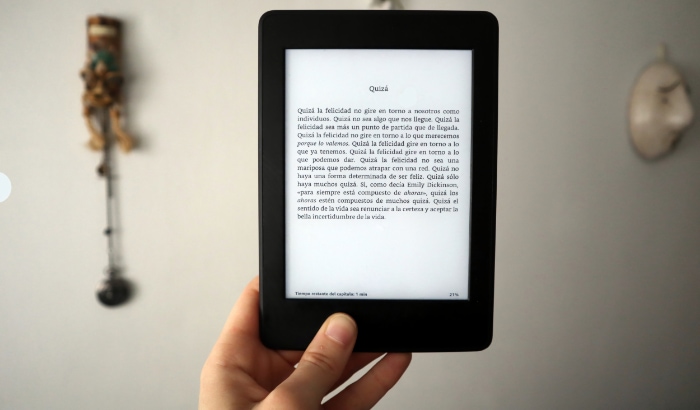Is 8GB Enough for Kindle? Your Reading Lifestyle Fit

Selecting the right Kindle model hinges on various factors, with storage capacity taking a prime spot in the decision-making process. Kindle, a widely recognized name in the e-reader market, offers an array of models, each boasting unique features and storage options.
Among these, the 8GB variant stands out as a popular choice. But does this amount of space truly suffice for your reading needs? This blog dives into the heart of this question, breaking down what 8GB storage means for your reading habits.
From the casual reader to the avid book enthusiast, we explore how different user profiles might influence the adequacy of this storage capacity.
Understanding Kindle’s Storage Capacity
When it comes to e-readers, the Kindle has established itself as a household name. One key feature that often influences purchasing decisions is its storage capacity.
Here, we’ll break down what 8GB means for Kindle users, compare it with other models, and discuss the types of content you can store.
What Does 8GB Mean in Practical Terms?
8GB, in the context of a Kindle, refers to the amount of data it can hold. To put it into perspective, this is equivalent to thousands of e-books.
However, it’s not just about quantity. The type of content—whether they are text-heavy novels or graphic-intensive comics—affects how much you can store.
Understanding the capacity of 8GB helps set realistic expectations for your reading and storage habits.
Kindle Models and Their Storage Options
Amazon offers Kindles in various storage capacities, ranging from the basic 8GB model to ones with larger memory. Higher storage models are designed for those who need more space for content like audiobooks or graphic novels.
Comparing these models helps you appreciate the versatility and range of options available, guiding you in selecting a Kindle that aligns with your reading preferences.
Types of Content You Can Store
The Kindle is not just for reading text-based books. Users can also store audiobooks, PDFs, and other document formats.
The storage needs for these different types of content can vary greatly. For instance, audiobooks require significantly more space than traditional e-books.
A thorough understanding of these differences is vital for making the most out of your Kindle’s storage capacity.
Analyzing the Size of E-books and Other Content
The actual storage capacity of a Kindle, especially the 8GB model, is closely tied to the size of the content it holds. Different types of digital content, from e-books to audiobooks, occupy varying amounts of space.
Average Size of E-books
E-books are the primary content type for Kindle users. Most e-books are relatively small in size, typically ranging from 1MB to 5MB.
This variation depends largely on the length of the book and the presence of images or other graphic elements. Given these sizes, a Kindle with 8GB of storage can hold a large number of e-books, making it an ideal choice for avid readers who focus mainly on text-based content.
Comparing Audiobooks and PDFs
Audiobooks and PDFs are significantly larger in file size compared to standard e-books. An average audiobook can range from 50MB to several hundred megabytes, depending on the length and audio quality.
PDFs, particularly those with high-resolution images or complex layouts, can also occupy more space than a typical e-book. Users who frequently use their Kindle for these types of content need to be more mindful of their storage limits.
Impact of Graphics and Interactive Content
E-books with heavy graphical content, such as comics or interactive books, require more storage space. These types of e-books can be several times larger than a standard text-based book due to the high-resolution images and interactive elements they contain.
Users who enjoy these kinds of reading materials should consider how these larger file sizes might affect their Kindle’s storage capacity.
User Profiles: Who Needs More or Less Storage?
The right amount of storage on a Kindle largely depends on the user’s reading habits and the types of content they prefer. By examining different user profiles, we can better understand who might need more or less than the standard 8GB of storage.
Profile of a Casual Reader
Casual readers, who might read a few books a month, predominantly text-based novels or non-fiction, are likely to find 8GB more than sufficient. These readers typically don’t store large quantities of books on their device at once and may not dive into graphic-intensive content or audiobooks, which require more storage space.
For them, the basic Kindle model offers an economical and practical solution.
Profile of a Voracious Reader
Voracious readers, with their extensive and diverse reading lists, might require more storage. These users often juggle multiple books at once, including graphic novels, interactive e-books, and perhaps a mix of audiobooks.
The higher file sizes of these materials can quickly consume storage space, making a Kindle with more than 8GB a more suitable choice to accommodate their expansive and varied library.
Special Considerations for Graphic-Heavy Content and Audiobooks
Users who predominantly engage with graphic-heavy e-books, such as comics, or who frequently listen to audiobooks, face unique storage demands. These formats are considerably larger than traditional e-books, meaning the storage fills up faster.
For such users, opting for a Kindle with increased storage capacity is advisable to ensure they have ample space for their preferred content without constant need to archive or manage their library.
The Role of Cloud Storage in Managing Kindle Content

Cloud storage plays a crucial role in enhancing the usability and flexibility of Kindle devices, especially when it comes to managing content. This feature allows users to store and retrieve books from a virtual library, providing a solution to the limitations of physical storage on the device.
How Amazon’s Cloud Storage Works for Kindle Users
Amazon’s cloud storage offers a seamless way to store purchased books. When you buy an e-book, it’s automatically saved to your cloud account, from where you can download it to your device.
This means that even if your Kindle has limited storage, you can access your entire library through the cloud. This system is particularly beneficial for managing large collections, as it reduces the need to keep all your books downloaded on the device.
Benefits of Cloud Storage for Managing a Larger Library
The primary advantage of cloud storage is the convenience it offers. You can access your books anytime, as long as you have an internet connection.
This feature is especially handy for users with an 8GB Kindle, as it effectively expands their library beyond the device’s physical capacity. It also simplifies library management, allowing users to easily switch out books on their device without losing access to their collection.
Limitations of Relying on Cloud Storage
While cloud storage offers numerous benefits, it’s important to note its limitations. The most significant is the dependency on an internet connection.
Without internet access, you can’t download books from the cloud to your Kindle. Additionally, the speed of downloading books can vary based on your internet connection.
These factors are important to consider, especially for users who frequently travel or live in areas with limited internet access.
Factors to Consider When Choosing a Kindle Model
Selecting the right Kindle model involves more than just considering storage capacity. Various factors contribute to the overall reading experience, each playing a crucial role in determining the best Kindle for your needs.
From screen size to battery life, these elements should be carefully weighed before making a purchase.
Screen Size and Display Quality
The size and quality of the Kindle’s screen are paramount for a comfortable reading experience. Models with larger screens offer more reading space, which can be beneficial for those who prefer larger text or read content with complex layouts, like magazines or PDFs.
Additionally, the resolution of the screen affects how crisp and clear the text and images appear, contributing to the ease of reading.
Lighting and Readability
Kindle models vary in their lighting capabilities. Some have built-in front lights, while others offer more advanced lighting features like adjustable color temperature.
These lighting options play a significant role in reducing eye strain and enhancing readability in various lighting conditions, from bright daylight to a dark room.
Battery Life and Durability
Battery life is a critical consideration, especially for avid readers or those who travel frequently. Some Kindle models offer longer battery life than others, ensuring that you can read for weeks on a single charge.
Additionally, the overall durability of the device, including its resistance to water and wear, is an important factor for those who read on the go or in different environments.
Price and Value Assessment
The cost of different Kindle models varies, often reflecting their features and capabilities. When selecting a model, it’s important to assess the value you’re getting for the price.
Consider whether the additional features of a more expensive model align with your reading habits and requirements.
Long-Term Considerations
Think about your future reading needs when choosing a Kindle. If you anticipate your library expanding significantly or your reading habits evolving (for instance, shifting towards audiobooks or graphic-heavy content), opting for a model with more storage or advanced features might be a wise long-term investment.
Conclusion
Choosing the right Kindle model with the appropriate storage capacity is a decision influenced by various factors. From the casual reader to the voracious book lover, everyone’s needs differ.
For those with a penchant for text-heavy novels, an 8GB Kindle often suffices, offering ample space for thousands of books. However, enthusiasts of audiobooks, graphic novels, and interactive content might find themselves needing more room.
Cloud storage emerges as a helpful tool in this scenario, expanding the horizons of your virtual library, albeit with some limitations like internet dependency.
Beyond storage, other features like screen size, lighting, battery life, and durability play pivotal roles in the overall reading experience. A model that aligns with your specific reading habits and future needs ensures both satisfaction and value for money.
Remember, the choice of a Kindle model is more than just a matter of storage; it’s about selecting a companion that fits seamlessly into your literary world. By carefully considering these aspects, you can find a Kindle that not only stores your favorite books but also enhances your reading journey.


